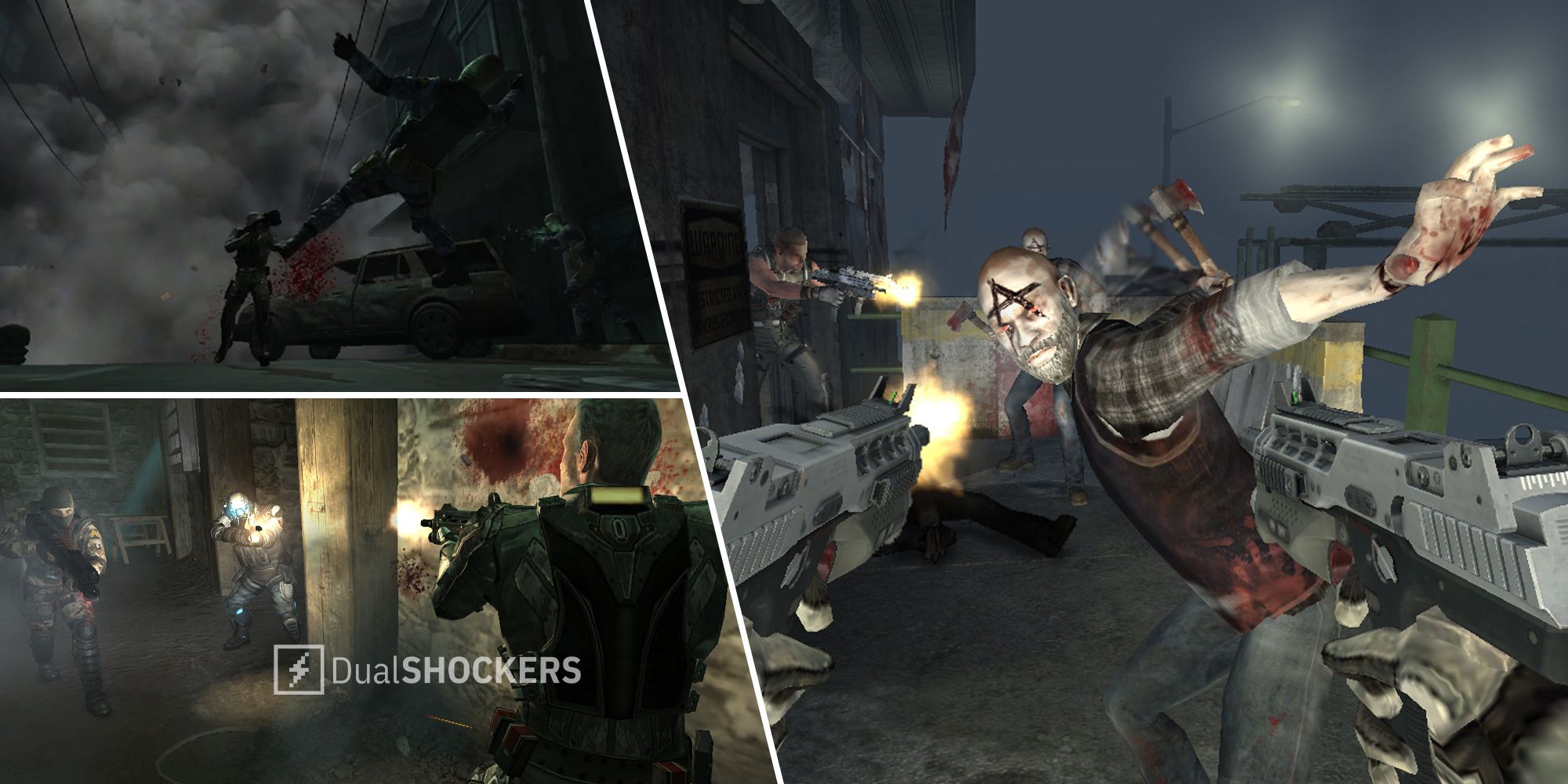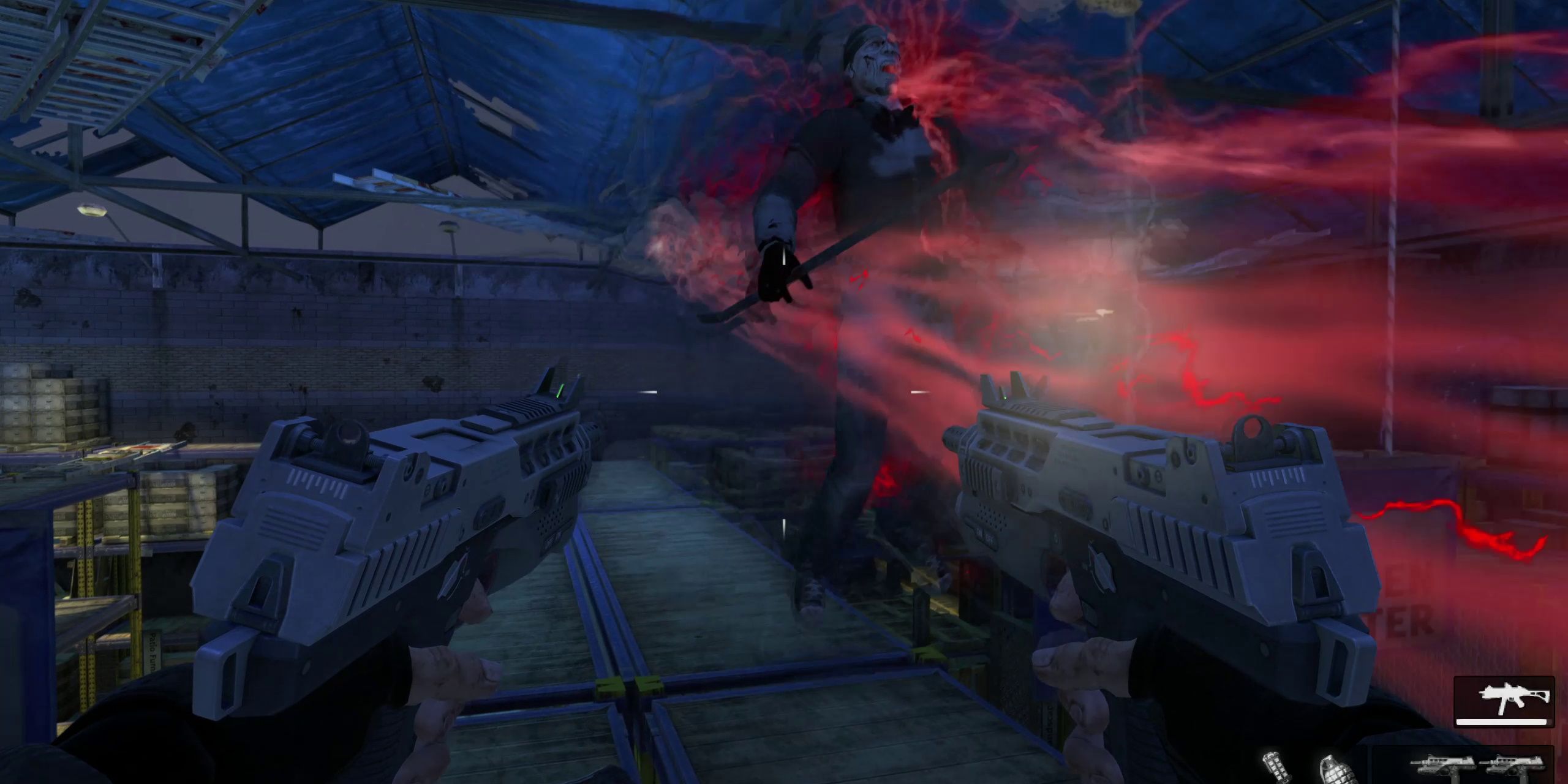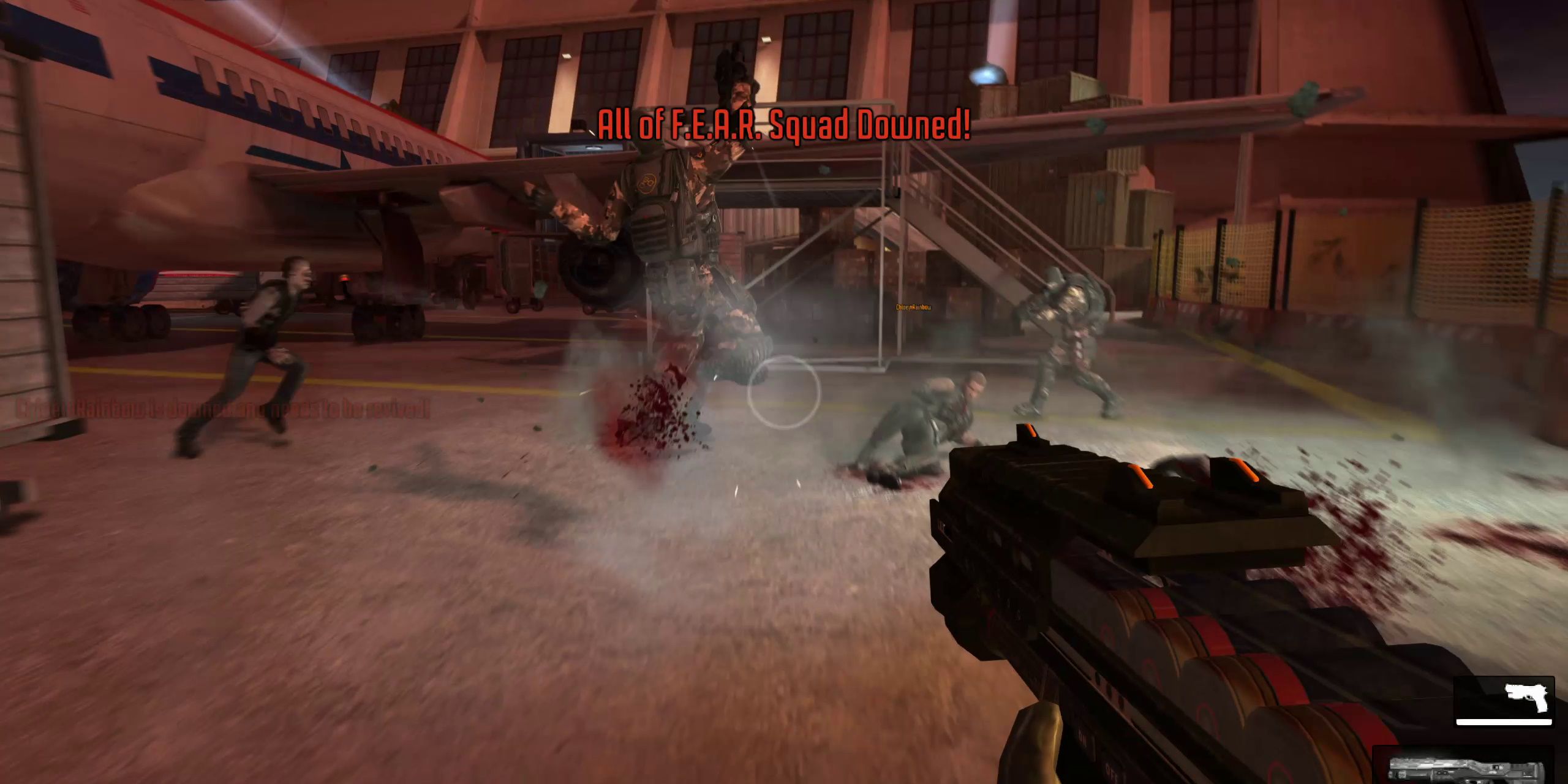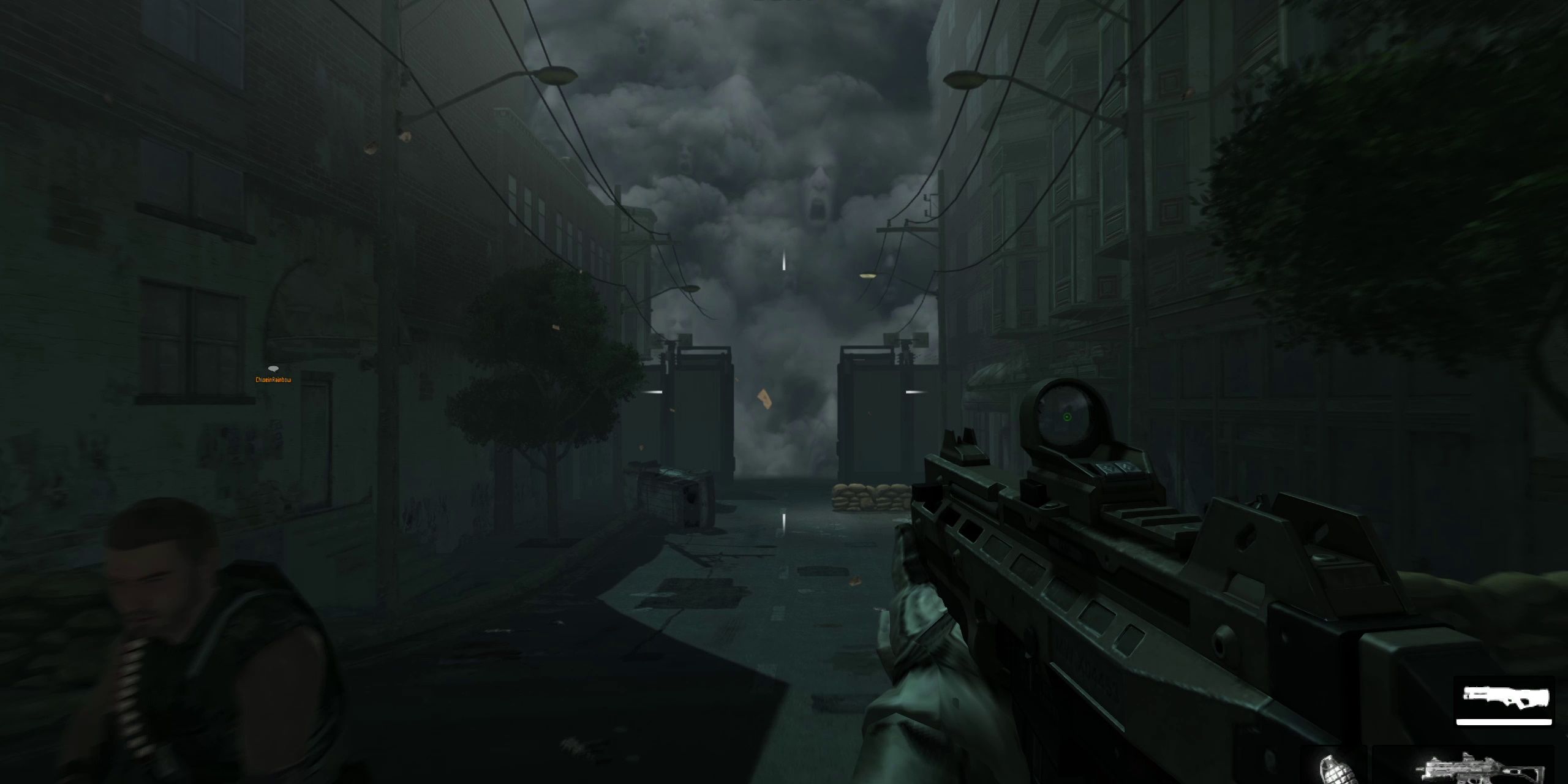F.E.A.R. 3 (or F.3.A.R. if you’re a marketing executive) isn’t a great singleplayer game. It’s fine, competent even, but Day One Studios had an unenviable task in trying to wrap up Monolith’s F.E.A.R. series. With two timelines and two highly different styles of horror attempted in its wake, F.E.A.R. 3, well, it tries its best.
Fortunately, story isn’t the priority of F.E.A.R. 3. . Narrative kneels to action here, restoring the fluidity of the first game with some extra movement options and a whole new focus on multiplayer.
Which you’d think would be a bad thing, right? A horror game should be terrifying and solitary, surely. Well, there’s ironically more panic in multiplayer than singleplayer, and not just because of the aforementioned laughable narrative. You see, F.E.A.R. 3 is genuinely built around multiplayer. There’s nothing ‘tacked on’. None of the modes follow traditional design conceits, and the co-op is so integral to the campaign that the cutscenes presume you’re playing with a friend regardless.
F.E.A.R. 3’s co-op is incredibly well integrated, while offering wildly asymmetric design. Player one returns to the role of Pointman from the first game, all his time manipulation powers intact; meanwhile your partner gets to possess and levitate enemies as Paxton Fettel. Each has distinctly different priorities moment to moment.
You’re each competing for Alma’s favor - whichever of you scores the highest gets their ending.
Paxton needs to keep killing enemies so he can consume their souls, letting him maintain possession over whichever enemy he currently inhabits. It demands the player approach fights more like Doom Guy than Marcus Fenix - forward-moving aggression rather than darting from cover to cover. By contrast, Pointman is rewarded for tactfully flanking enemies, harnessing a fluid first-person cover system that works far better than it has any right to.
When without a body, Paxton is the perfect telekinetic support for Pointman, able to hoist snipers and tougher enemies into the air, throw back grenades, shield Pointman from damage, and provide psychokinetic blasts. Pointman conversely provides Paxton with more souls to consume, each keeping the other going regardless of who’s pressing the advantage.
It works exceptionally well, bolstered by level design far more in line with F.E.A.R. and its expansions than Project Origin’s narrow hallways. They’re very obvious combat arenas because this was 7th gen and levels were still fairly compact to achieve a decent visual fidelity, but they’re varied and memorable. A haunted wholesaler marketplace, a Brazilian Favela, a collapsing airport, and twisted urban housing gone feral are just a fraction of the variety on display. There’s even a mech section that rivals the best moments in Monolith’s long forgotten mecha FPS, Shogo.
This is all enhanced by a unique competitive angle. You’re each competing for Alma’s favor - whichever of you scores the highest gets their ending, while the other ‘sibling’ is brought to heel. There are collectibles you can choose to share or be selfish with, potentially gaining an experience point edge over your partner. It’s nothing major, but it adds a neat incentive to engage in the approval system. The only other game to begin to try this was Call of Juarez: The Cartel, and it goes without saying that F.E.A.R. 3 does it far better than that pile of problematic code.
Whether in split-screen on console or online, F.E.A.R. 3 has four different four-player multiplayer modes, each miles ahead of their peers, and in one case, edging dangerously close to one of the most popular multiplayer games of its console generation. These modes are: Contractions, F***ING RUN!, Soul Survivor, and Soul King. No flags to capture or payloads to push - F.E.A.R. 3 tailors all its modes around a horror premise and runs with them as far as it can.
Contractions is arguably the most familiar, at first. It’s styled after Call of Duty’s zombies mode with a Silent Hill twist. Rather than just fighting off hordes of enemies, you have to scavenge for supplies constantly, while being harassed by incorporeal ghosts and even Alma herself, who can curse you in a variety of ways; maybe she makes you go blind, or teleports you halfway across the map, or slows your movement speed to a crawl.
You never know what Alma will do, and she ambushes you without warning, as both Alma and her spectral assailants are entirely dynamic. This is in addition to each map having unique arsenal options afforded to you, with varying levels of verticality, different enemy spawns, and even a mech on one map that you can pilot - at the risk of being ripped out of it by Alma’s malicious might.
From here, things get weird. F**ING RUN! is equal parts a co-op speedrun gauntlet and and Final Destination (which was very big at this weird time for horror movies). You and your squad have to charge headlong into enemy forces without slow-mo, as a constant wall of death comes tearing down behind you with the spirits of the damned howling after you. While the simplest mode in design, it’s by far the hardest co-op challenge in the entire game, requiring precision from every party member.
After all that precision, you might want to unleash a little mayhem on your friends, which is where the Soul modes come into play. Soul Survivor is, I kid you not: Among Us meets Counter-Strike. A team of F.E.A.R. operatives are deployed to an area full of enemies, only for one random team member to be transformed into a demon. You then proceed to hunt down your comrades one by one.
Each ally you convert becomes another demon, escalating the threat until it’s one survivor dueling three friends in an intense Running Man gauntlet around the map. It’s worth noting that each mode’s maps are entirely unique to that mode. Contractions feels like a desperate last stand, F***ING RUN! is made of breathless corridors, and Soul Survivor throws you into parkour jungle gyms with as many flanking routes as there are ways to escape the demons. It’s genius work given these were all such unconventional modes in an era where most multiplayer shooters just copied Call of Duty.
That said, the final mode in play does copy a bit from one other highly popular multiplayer game - Mario Kart. Soul King is a free-for-all mode, but kills alone don’t cut it; instead, everyone’s a demon, and they’re all being hunted by Armacham corporate stooges that can be possessed. Your goal is to score the most souls within the time limit amid the small-scale battle royale. Taking out other players lets you steal their points, capturing the chaos of Mario Kart’s battle mode in a Freddy Vs. Jason-style fight to see who’s the greatest ghoul of all!
It’s exceptionally great fun, and the beautiful benefit of only needing two to four players is that putting a private match together takes little to no effort. F.E.A.R. 3 regularly goes on sale for next to nothing, still has full online functionality, and is even backwards compatible on Xbox. The barrier to entry is so low and the lack of any real grind - the only upgrades that matter are unlocked in the campaign - means everyone is on an even playing field.
So if you fancy a frantic fight with some friends, pick up F.E.A.R. 3. It might not be the epilogue fans of the original were hoping for, but it’s darn good fun!




